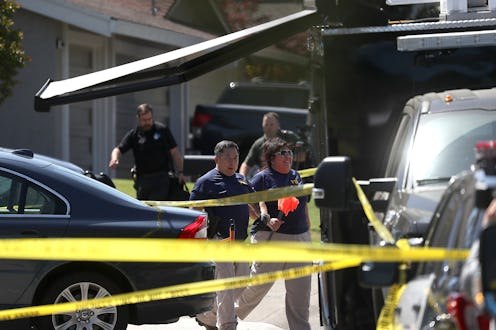News
How Cops Caught The Golden State Killer Thanks To A Random At-Home DNA Test

How do you catch a notorious serial rapist and killer in a decades-old cold case? If you're anything like investigators in Sacramento, you turn to open-source genealogy websites. Police caught the Golden State Killer with a help from genetic information voluntarily submitted to a genealogical website, The Sacramento Bee has reported. According to the Sacramento County District Attorney's Office, it wasn't even the killer who'd supplied the genetic information that led police to capture one of America's most heinous criminals — it was a relative.
Neither DNA technology nor the world wide web were around when the so-called Golden State Killer first began his decade-long crime spree in 1976. As a result, although the notorious serial rapist and killer rarely left incriminating evidence like fingerprints at his crime scenes, what he did leave behind — DNA — was of little help to police at the time. But now, thanks to advancements in DNA technology and the popularity of genealogy websites, that DNA evidence is ultimately what brought the Golden State Killer down.
According to The Sacramento Bee, investigators compared DNA samples collected decades ago from one of the Golden State Killer's crime scenes to information voluntarily made available on an "open source" genealogy website designed to help users learn more about their ancestry. Chief Deputy District Attorney Steve Grippi told the paper that investigators spent a long period of time exploring the family trees of users whose genetic profiles appeared to match the Golden State Killer's DNA sample.
But not all genealogy websites allow law enforcement free rein to peruse users' genetic profiles. According to The Atlantic, sites like 23andMe and Ancestry don't hand over users' information without a court order. Nor could police have submitted the DNA evidence they had from the killer to either of the sites as both require a tube of saliva for testing.
What's more, both sites have denied having having been involved. Vitagene and MyHeritage have also denied having been involved in the case, according to CNN. Instead, investigators are likely to have used what's known as free or "open-source" websites where users voluntarily share their genetic profile with the aim of expanding their genealogy research. According to San Jose's Mercury News, the Sacramento District Attorney's Office has not specified which site it was that led them to identifying the killer.
However, Paul Holes, a cold case investigator who worked as one of the lead investigators on the Golden State Killer case up until his retirement in late March, told The Mercury News that one of the sites his team found most helpful when it came to identifying potential suspects was GEDmatch. The third-party site doesn't carry out DNA testing but rather processes test results users obtained through other websites in order to connect them to individuals with matching DNA who may have tested through other sites.
According to The Sacramento Bee, investigators were led to the alleged killer after combing through the family tree of someone whose genetic profile appeared to match the DNA evidence investigators had on hand. Investigators searched for relatives who fell into a specific age range and who had lived in areas where and when the crimes had taken place.
When investigators hit upon the man they would later arrest as a suspect, they obtained his DNA from something he'd discarded while under police surveillance and tested it against the DNA evidence the killer had left at a crime scene decades earlier. Sacramento County District Attorney Anne Marie Schubert told The Sacramento Bee the results provided "overwhelming evidence that it was him."
The Golden State Killer, who was also known to authorities as the East Area Rapist and the Original Night Stalker, is alleged to have carried out at least 12 homicides, 45 rapes, and more than a hundred home invasions in communities across California in the '70s and '80s.